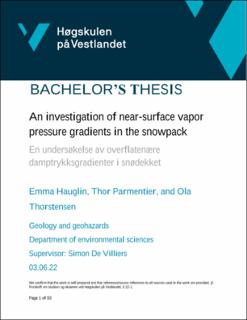| dc.contributor.author | Hauglin, Emma | |
| dc.contributor.author | Parmentier, Thor | |
| dc.contributor.author | Thorstensen, Ola | |
| dc.date.accessioned | 2022-09-16T08:57:44Z | |
| dc.date.available | 2022-09-16T08:57:44Z | |
| dc.date.issued | 2022 | |
| dc.identifier.uri | https://hdl.handle.net/11250/3018355 | |
| dc.description | Geology and geohazards
Department of environmental sciences
Supervisor: Simon De Villiers
03.06.22 | en_US |
| dc.description.abstract | The formation of near-surface faceted crystals caused by diurnal recrystallization has been observed by Birkeland et al. (1998). Lab experiment results by Pinzer and Schneebeli (2009) showed that oscillating temperature gradients did not lead to faceting. This thesis investigates if real-world asymmetry in the near-surface vapor pressure gradients is a prerequisite for the process of diurnal recrystallization. Two mechanisms for asymmetry are hypothesized, (1) the effect of warm snow having a higher equilibrium vapor pressure than cold snow, and (2) differences between heating and cooling of the snowpack. To explore vapor pressure gradients, a numerical model was developed by solving the 1D heat equation in Excel using the finite difference method. The model predicts temperature evolution in a snowpack which allows for the calculation of vapor pressure gradients at high resolutions. Field work was conducted where metrological data and snow temperatures were collected to calibrate and evaluate model performance. Lastly, a function to quantify facet growth rate by vapor pressure gradient was developed to analyze the mechanisms of asymmetry. Sub-faceting gradients are not considered. Though the model has weaknesses such as the use of sensible heat as a fitting parameter and the use of a constant solar radiation extinction coefficient, it produces plausible temperatures and vapor pressure gradients. The results indicate that asymmetry in the heating and cooling of the snowpack (hypothesis 2) is more important for diurnal recrystallization than the effect of temperature (hypothesis 1) alone. When working in tandem, the effect of temperature can amplify the asymmetry in heating and cooling. Mean negative temperature gradients in the snowpack lead to negative facet growth being the dominating process deeper than 2 cm. Negative vapor pressure gradients are maintained in the top 0 – 1 cm, in a combination of diurnal recrystallization and radiation recrystallization. | en_US |
| dc.language.iso | eng | en_US |
| dc.publisher | Høgskulen på Vestlandet | |
| dc.rights | Navngivelse 4.0 Internasjonal | * |
| dc.rights.uri | http://creativecommons.org/licenses/by/4.0/deed.no | * |
| dc.title | An investigation of near-surface vapor pressure gradients in the snowpack | en_US |
| dc.title.alternative | En undersøkelse av overflatenære damptrykksgradienter i snødekket | en_US |
| dc.type | Bachelor thesis | en_US |
| dc.source.pagenumber | 93 | en_US |
| dc.description.localcode | GE491 | en_US |

